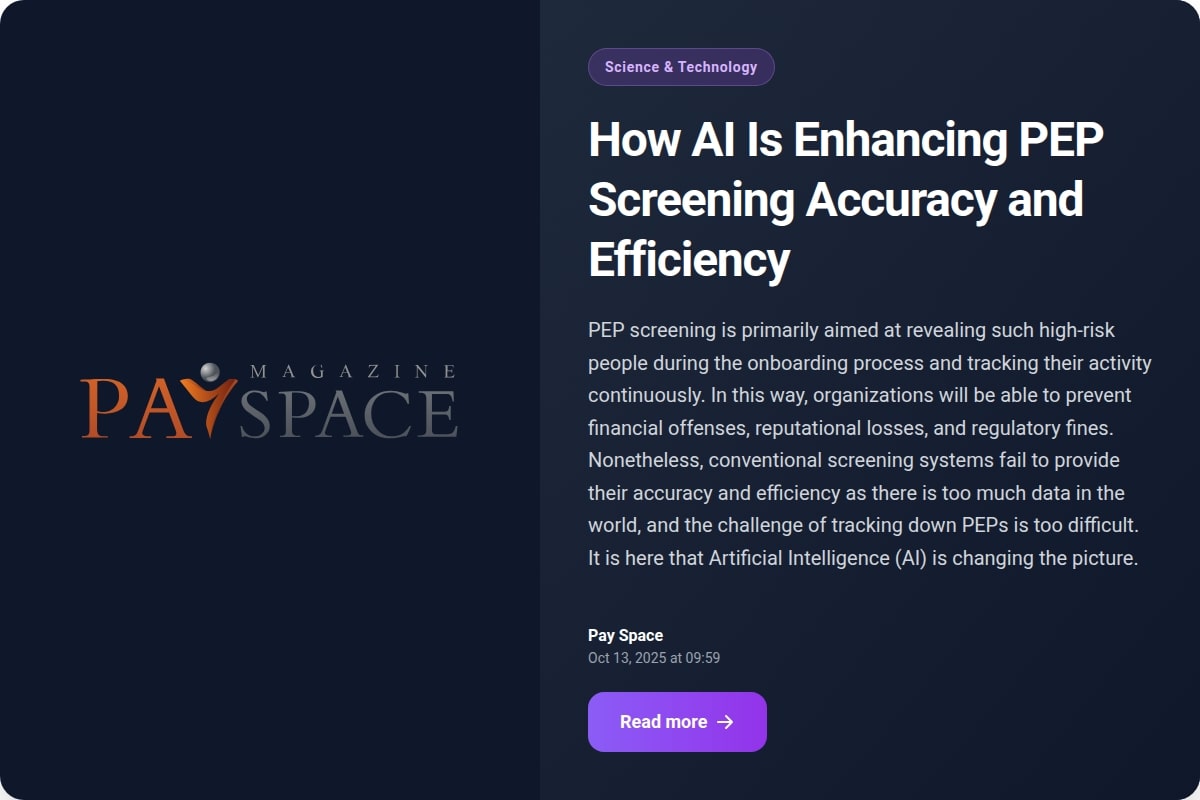 Ethan Lewis, Content Writer.
Ethan Lewis, Content Writer.
Ethan Lewis is a passionate writer who loves to explore new technologies. He has a good amount readership that follows him for his exceptional work in AI, Crypto, Gaming, Fintech, and Cyber Security. He is always excited to pour the technology into his words.
Importance of PEP Screening in Preventing Financial Crime
Politically Exposed Persons (PEPs) are those people who have or once held positions of influence in the government, including a head of state or government official, or executive of a state-owned company. The PEPs, due to their status and influence, are more vulnerable to engaging in bribery, corruption, or money laundering. It is because of this that PEP screening is a critical constituent of anti-money laundering (AML) and compliance practices by banks, financial institutions, and regulated businesses.
PEP screening is primarily aimed at revealing such high-risk people during the onboarding process and tracking their activity continuously. In this way, organizations will be able to prevent financial offenses, reputational losses, and regulatory fines. Nonetheless, conventional screening systems fail to provide their accuracy and efficiency as there is too much data in the world, and the challenge of tracking down PEPs is too difficult. It is here that Artificial Intelligence (AI) is changing the picture.
Problems with Traditional PEP Screening Procedures.
Before the advent of AI, compliance teams used to use mostly static databases and a manual key search engine to find PEPs. These old-fashioned approaches posed a number of difficulties.
First, the problem of accuracy: manual searches usually provide many false hits, people who have a similar name to PEPs but are not really related. On the other hand, false negatives are cases where the system is unable to identify a real PEP because of spelling differences, inconsistency of data, and incomplete information.
Second, the problem of efficiency: it consumes a lot of time and resources to manually verify each alert or possible match. The compliance officers usually spend a lot of hours checking names and cross-checking information, hindering the overall process of customer onboarding.
Lastly, the data limitation: traditional systems refer to the structured and predefined sources of data. This implies that they can miss information of interest contained in unorganized data that includes news coverage of the world, government files, or posts on social media- all of which could contain essential context on potential risks.
AI in the New Era of PEP Screening.
The Artificial Intelligence provides a smarter, quicker, and more flexible means of managing the screening of PEPs. Machine learning (ML) and natural language processing (NLP) are examples of AI technologies that can analyze large volumes of data and make minimal patterns, as well as constantly improve as time goes on.
Rather than matching names directly, AI-powered systems review contextual data, such as job titles, affiliations, geographic locations, and prior histories, to inform an answer about whether a person actually qualifies as a PEP. This significantly lowers false positives at the expense of enhanced accuracy.
In addition, AI-driven solutions can handle data globally in real-time, which provides compliance teams with timely notifications whenever new risks emerge. This reactive-to-proactive risk management change is one of the most significant changes to AML compliance.
Improving Accuracy in the Screening with Machine Learning.
AI-driven PEP screening entails machine learning. Through the training on big datasets of confirmed PEPs, ML models are trained to identify complex relationships that traditional systems may not identify.
As an example, an ML model would be able to identify instances of the appearance of a person’s name associated with government positions, political contributions, or corruption issues, despite the data being displayed in various formats or languages. This analysis can then be used to assign a risk score by the model, and this enables the compliance teams to prioritize investigations in a better way.
These models can be more refined as time passes and new data is processed, which will automatically correct their standards and reduce the possibility of human error. The outcome is an ever-evolving learning system that becomes smarter with each screening.
Boosting Efficiency Through Automation and Real-Time Monitoring
The other significant input of AI is that it can be used to automate monotonous compliance procedures. The AI systems can scan the global watchlists, sanctions lists, and adverse media sources 24/7 rather than being manually checked in databases.
This automation implies that compliance officers should get real-time notices whenever the risk profile of a customer is altered in some ways, such as being assigned a governmental job or being reported in a corruption-related story. In addition to accelerating the working processes, real-time monitoring allows making sure that none of the critical updates are missed.
The AI also enables risk-based segmentation, which enables the institution to group customers based on their level of risk. More frequent monitoring of high-risk profiles may be performed, and less frequent manual checks of low-risk ones may be conducted. This focused strategy is resource optimization and compliance efficiency.
The Natural Language Processing Power in PEP Screening.
Natural Language Processing (NLP) helps AI to read and comprehend human language even when it is used in many languages and regions. This is especially applicable in the case of adverse media and background screening, wherein any material of interest could be found unorganized in a non-formatted format, like a news report, blogs, or legal document.
NLP-driven software can identify and understand valuable words, emotions, and connections in text to determine whether an article suggests corruption, fraud, or political vulnerability. As an example, an NLP model can distinguish the difference between John Smith being investigated for bribery and John Smith being praised as being transparent, and the right context is taken into account.
Such in-depth knowledge makes a considerable contribution to the quality of PEP screening and ensures that the compliance teams are informed with the relevant, accurate, and timely insights.
Ongoing Due Diligence using AI-Driven Systems.
PEP screening is not a set one-off exercise that would conclude, but a continuous due diligence that would monitor the variation in the risk profile of customers. The conventional systems cannot deal with constant monitoring as they work with manual updates. AI, in its turn, is capable of automatically updating information and identifying new data concerning the political exposure or crime investigation of an individual.
Artificial intelligence-based systems constantly gather and process information of worldwide origin to update the profiles. This will enable the institutions to be in line with the emerging regulatory provisions such as FATF, FinCEN, and EU AML regulations. It also reduces the chances of having old records or missed red flags.
The Future of PEP Screening: More Intelligent, Less Secret.
With technologization, the use of AI in compliance would continue to grow. The future development of the PEP screening tools will probably involve predictive analytics, where institutions can foresee the occurrence of risks before they become real. Connection to blockchain data can also enhance the visibility and identity checks.
Those financial institutions that invest in AI-based PEP screening nowadays are setting themselves up in the long term, in order to succeed. Such systems not only will minimize the cost of operation and compliance risk, but will also help to develop trust both with the regulators and customers.
The implementation of AI turns the PEP screening into not a manual and reactive procedure but rather a multidynamic, intelligent model that can identify the risks most accurately and quickly ever. Such innovation is not only desirable in a rapidly more complicated financial ecosystem, but it is necessary to the sustainability of financial integrity in the global system.











